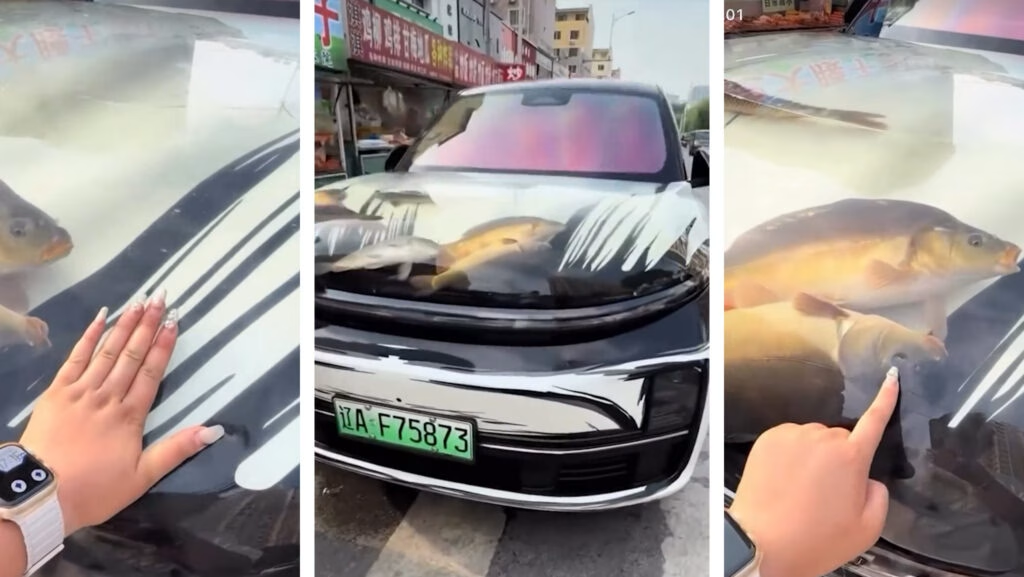Why Did Someone Turn a Li Auto L9 Into a Fish Tank?
You might think you’ve seen every wild car modification out there—until you come across a Li Auto L9 SUV with a full-blown aquarium built into its hood. Not a clever wrap or a quirky paint job, but an actual, water-filled tank with live fish swimming under a sheet of plastic. The story behind this bizarre sight? The owner reportedly forgot his fishing bucket and, in a moment of improvisation, decided his SUV’s hood would do the trick. Sometimes necessity is the mother of invention, but this one’s a head-scratcher.
What Actually Happened on That Busy Road in Liaoning?
Eyewitnesses in Liaoning province, China, couldn’t believe their eyes when they spotted the Li Auto L9 parked on the roadside, its hood transformed into a makeshift aquarium. Videos quickly made the rounds on social media, showing several large fish swimming beneath a sealed plastic film, with water visibly leaking from the edges. Locals gathered, phones in hand, to capture the spectacle. The footage is real—multiple sources confirm it, and the incident has sparked a wave of online commentary ranging from laughter to outright outrage.
Is This Just a Harmless Prank or Something More Serious?
At first glance, it’s tempting to laugh it off as a harmless prank or a viral marketing stunt. But dig a little deeper, and the mood shifts. Animal welfare advocates and everyday viewers alike have voiced concern for the fish, who were left gasping in a shallow, unfiltered tank on a hot car hood. The owner may have been proud of his quick thinking, but the reality for the fish was far from ideal. According to animal welfare experts, fish are highly sensitive to temperature and water quality—conditions that a car hood simply can’t provide. The result? Stress, suffering, and a strong case for leaving animals out of roadside showmanship.
What Are the Legal and Safety Implications of Modifying a Car Like This?
Beyond the ethical questions, there’s a legal side to this story. Local traffic police were called to the scene and quickly determined that the aquarium modification was illegal. Not only does it violate vehicle safety codes—imagine the distraction to other drivers—but it also poses a risk of water leakage, electrical damage, and impaired visibility. In China, as in many countries, vehicle modifications that compromise safety or animal welfare can lead to fines and even impoundment. The car was barred from being driven in this state, serving as a reminder that not all DIY ideas are roadworthy.
Why Do People Attempt Such Extreme Car Modifications?
Extreme car mods aren’t new, but this case is a fresh example of how far some people will go for attention or convenience. Sometimes it’s about standing out on social media; other times, it’s a spur-of-the-moment solution to a practical problem—like forgetting a fishing bucket. But as this story shows, the line between creative and careless can be thin. In a 2023 survey by the China Association of Automobile Manufacturers, over 60% of respondents said they’d seen unsafe or illegal car modifications in their city, with many citing social media as a driving factor. The takeaway? Viral fame often comes at a cost.
What Can We Learn About Responsible Car Customization?
If you’re tempted to personalize your ride, there are plenty of ways to do it safely and ethically. Think custom wraps, upgraded interiors, or performance tweaks that comply with local laws. Always check regulations before making changes—especially those that could affect safety or animal welfare. And if you’re transporting live animals, stick to proper containers and humane practices. The automotive world is full of innovation, but the best ideas are the ones that don’t put lives at risk.
A Final Word on Creativity and Common Sense
The big takeaway? Creativity isn’t about perfection—it’s about smarter adjustments. Start with one change this week, and you’ll likely spot the difference by month’s end. Whether you’re customizing your car or just looking for a laugh online, remember: sometimes the best ideas are the ones that keep everyone—fish included—safe and sound.

